
 Copyright © Michael Richmond.
This work is licensed under a Creative Commons License.
Copyright © Michael Richmond.
This work is licensed under a Creative Commons License.
This chapter discusses the mechanisms by which the universe evolved into a place that could give birth to our Solar System. It explains the physics which cause clouds of gas in space to collapse into stars and planets, and which cause these collapsing clouds to form flattened disks.
When you look up into the night sky, you see stars, a few planets, perhaps the Moon, and ... not much else. This region of the sky, for example, holds the constellation known as Orion. Some bright stars, yes, but lots of empty space in between them.

However, if you go to a very dark site, far from city lights, and take a long photographic exposure, you may see some faint wisps of gas here and there.

Image copyright
A. Vannini, G. Li Causi, A. Ricciardi, A. Garatti
But if you take a picture sensitive to infrared light, instead of the ordinary optical light detected by our eyes, the view is completely different: now glowing gas and dust overwhelm the stars.
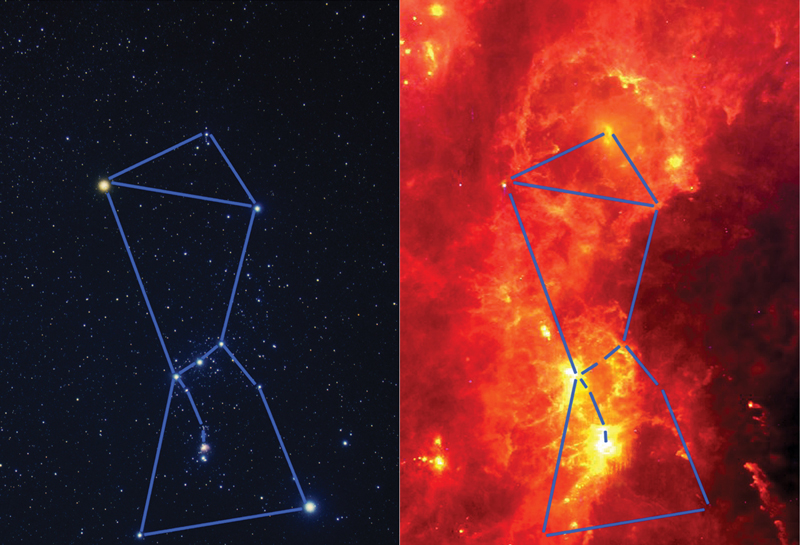
Optical image (left)
courtesy of Akira Fujii;
infrared image (right)
from IRAS courtesy of NASA
Why are some regions of space filled with gas and dust?
Well, long ago, when the universe was young, a few thousand years after the Big Bang, space was filled with NOTHING BUT gas. Hydrogen and helium gas, to be specific ( yes, yes, and miniscule amounts of lithium). These are the simplest of the chemical elements, and they were the only ones to be synthesized from nuclear reactions during the very early times when all of space was hot and dense.
time passes .....
After some hundreds of millions of years passed, some of the gas, which had collected into clouds, formed stars. We'll talk much more about this process later on during this lecture. Deep inside those stars, hydrogen fused to form helium, and helium fused to form heavier elements: carbon, oxygen, nitrogen, calcium, magnesium, and so forth.
As time passed, some of this material formed deep within the first generation of stars was ejected back into space. How? By three main mechanisms.

Image courtesy of
NASA, ESA, J. Hester and A. Loll (Arizona State University) <

Image courtesy of
NASA, ESA and the Hubble Heritage (STScI/AURA)-ESA/Hubble Collaboration
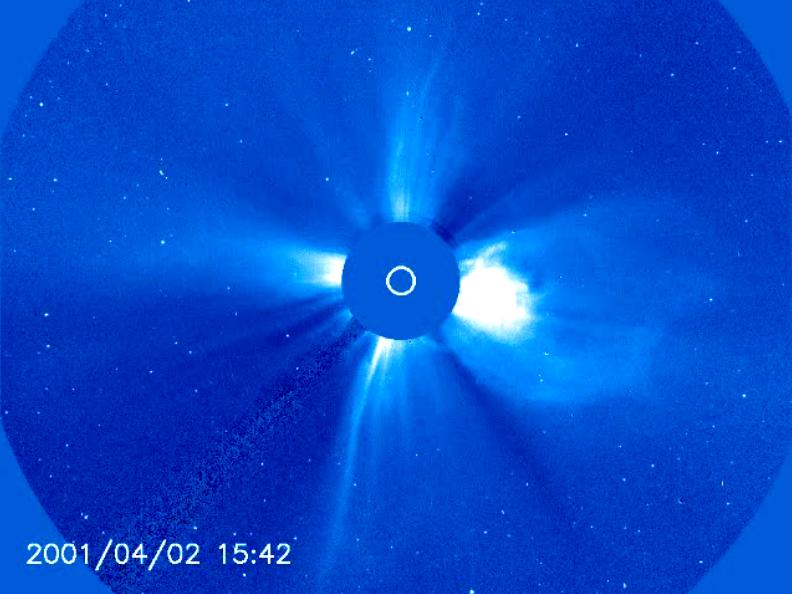
Video courtesy of
SOlar and Heliospheric Observatory (SOHO)/NASA/ESA
The result of all these processes was to inject into the Inter-Stellar Medium (ISM) bits of gas containing not only hydrogen and helium, but also all the heavier elements.
time passes .....
In some locations, clouds perturbed by random turbulent motions, shocks from nearby stellar winds and explosions, and their own self-gravity formed denser clumps and cores. In those dense regions, individual atoms combined to form molecules such as water (H2O), methane (CH4), ammonia (NH3), and others.
In particular dense regions, some molecules bumped into each other to create collections of hundreds or thousands or millions of atoms and molecules, which we call dust grains.
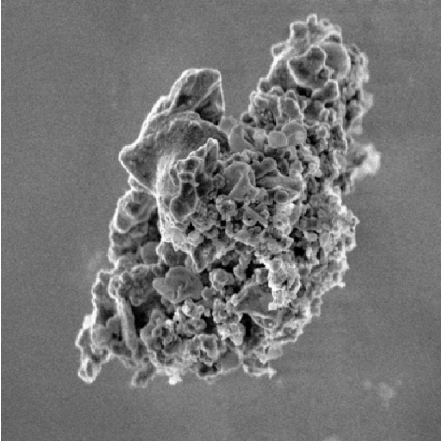
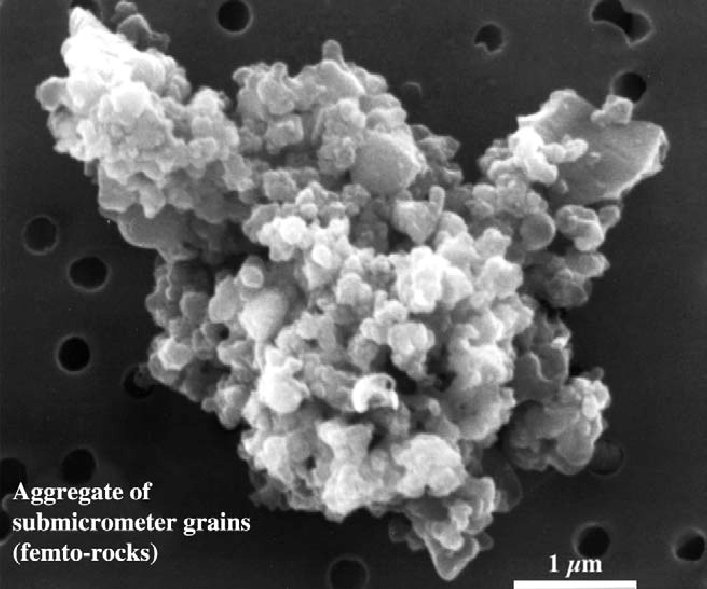
(left) Image taken from Schlosser, Reviews in Mineralogy and Geochemistry, 47, 701 (2002) (right) Image taken from Messenger, in "Meteorites and the Early Solar System II," ed. Lauretta and McSween, pp.187-208 (2006)
time passes .....
Several billion years after the Big Bang, multiple generations of stars have formed and exploded and formed and exploded, enriching the interstellar medium with more and more heavy elements. By the time our solar system started to form -- about 9 billion years after the Big Bang -- gas clouds in this region of the Milky Way Galaxy had a composition of roughly 75 percent hydrogen by mass, 24 percent helium by mass, and roughly 1 percent everything else.
So, roughly 4.6 billion years ago, a giant cloud of gas and dust filled the space between stars in what would become our corner of the Milky Way Galaxy. Viewed from a distance, it probably looked something like this:
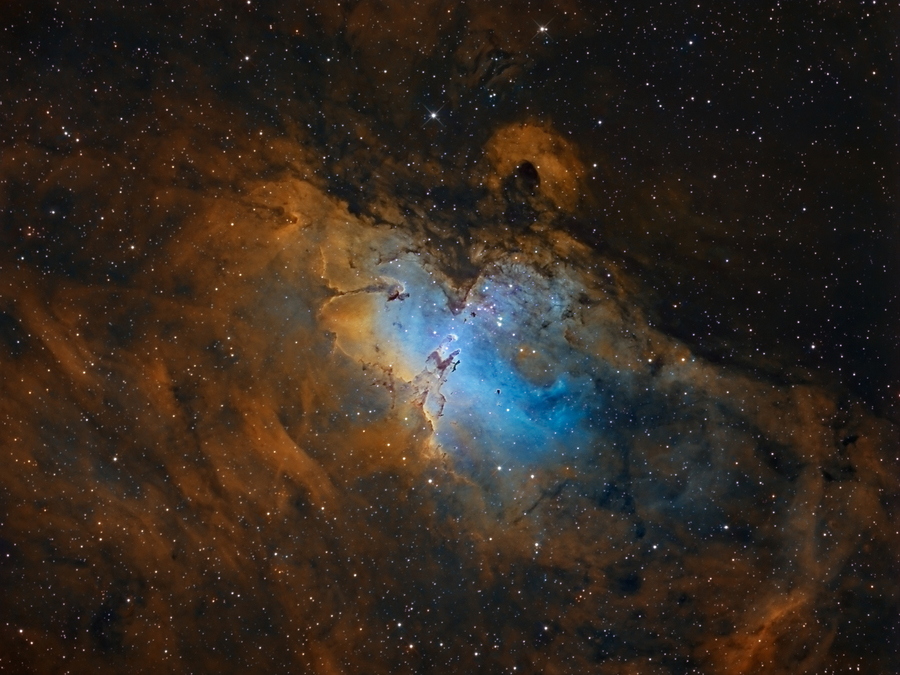
Image courtesy of
Jacek Bobowik and
European Astronomy Picture of the Day
This big cloud has already formed some hot stars, which shine bright and blue near the center of the picture. The light and winds of those hot young stars has carved out a hole in the cloud. Around the edges of this hole, we can see small portions of the cloud which are forming little clumps.
Let's zoom in on one of those regions where clumps are forming:

Image courtesy of
Jacek Bobowik and
European Astronomy Picture of the Day
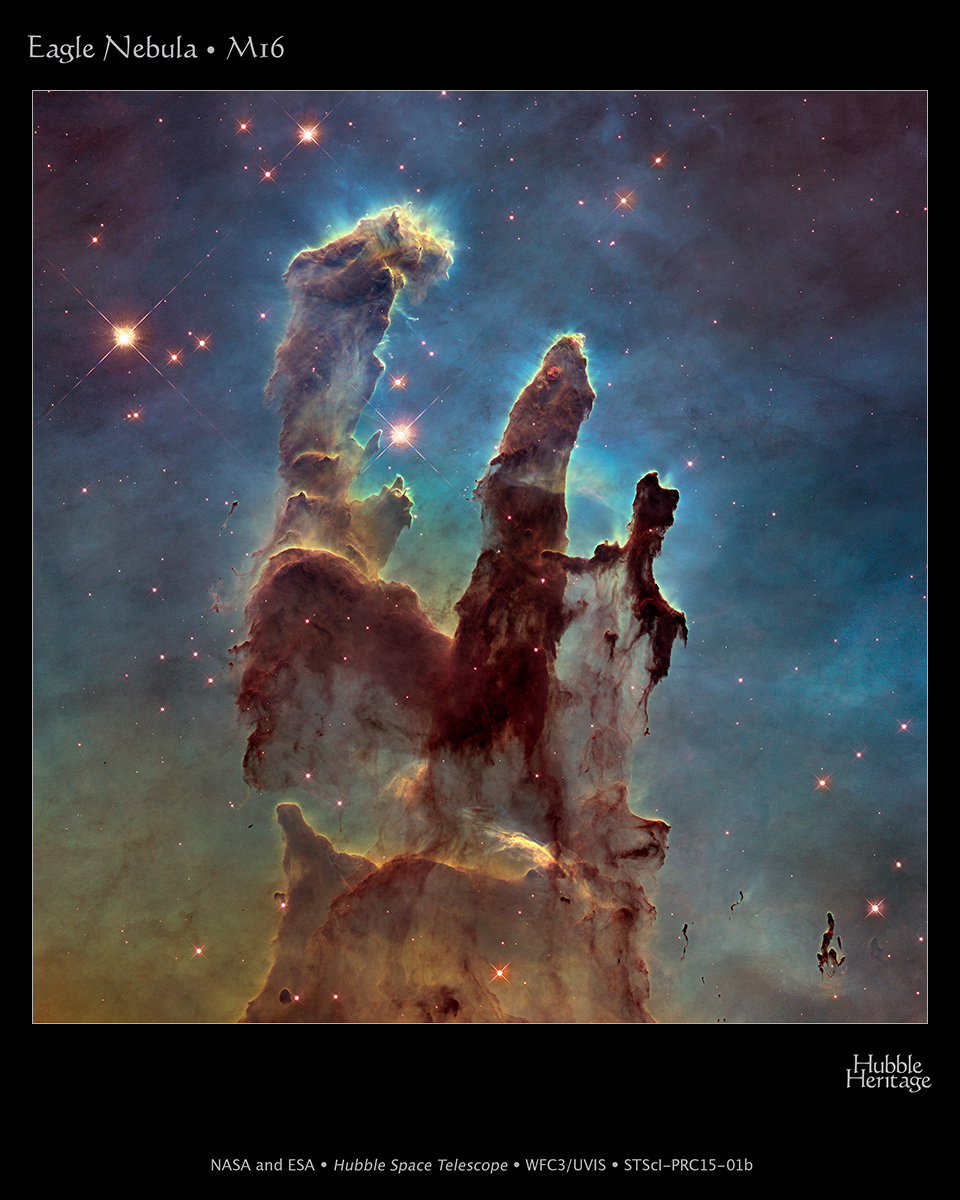
Image courtesy of
NASA, ESA, and the Hubble Heritage Team (STScI/AURA)
Why do these little regions of the cloud collapse and form dense little cores? Hmmmm.
Q: What force could cause a cloud of gas and dust
particles to shrink inward on itself?
The answer, of course, is gravity. Gravitational forces pull objects together: atoms in a cloud, atoms in your body, people in this classroom. Fortunately for us, the gravitational forces between everyday, ordinary objects are very, very small; and other forces, such as the electric repulsion of electrons between atoms, or the forces exerted by our muscles, are much larger.
In fact, gravity is the weakest of the fundamental physical forces. But out in space, in the middle of a cloud, the gravitational force of all the atoms on each other does add up.
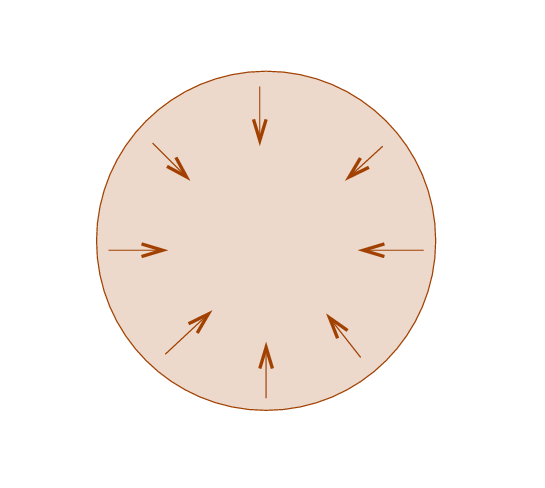
So, why don't ALL clouds immediately start to collapse?
Q: What keeps most clouds of gas from collapsing?
The answer is thermal motion. Inside any cloud of gas, the individual atoms and molecules are zooming around, bumping into each other and flying away again. The speed of the particles depends on the temperature of the gas: higher temperatures correspond to faster particles.
If the temperature is high enough, then the individual atoms and molecules keep bumping into each other and knocking each other apart. That prevents most clouds from collapsing.
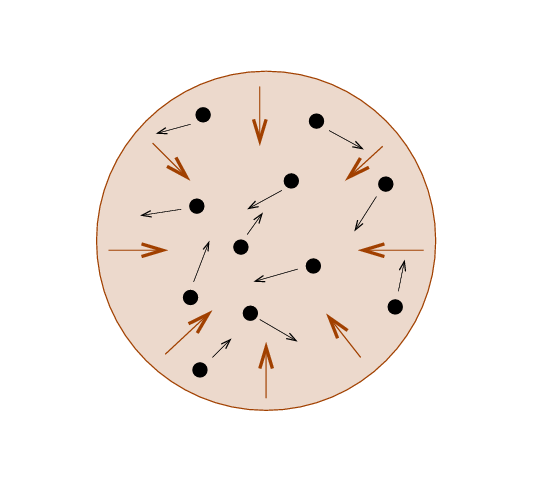
Most clouds in the space between the stars are pretty warm: their temperatures are perhaps 50 to 100 Kelvin, or even higher.
You know about the Kelvin temperature scale, right?
At those "high" temperatures, the particles inside a typical cloud have too much kinetic energy to be pulled together by gravity. But if some little region of a cloud happens to be a little denser, or a little dustier, than usual, starlight might not be able to penetrate to its inner depths. That could cause the innermost regions to cool off to only 10 Kelvin, or even lower temperatures. If that should happen, the atoms would be moving so slowly -- just a measly 290 meters per second -- that gravity might win, and the cloud might start to collapse.
When that happens, the inner regions of the cloud collapse more quickly, causing them to become more dense, causing them to collapse more quickly, and so on and so on. As the outer layers fall inwards and onto the central dense layers, they smash into it and heat it up. The central region heats up due to this accretion of material.
The result is that, while the outer regions of the cloud are still cold, the inner regions are warmer, and the innermost material condenses into a very dense object. As more gas continues to fall onto this central object, it splashes down, converting its kinetic energy into heat. The central object grows hotter and hotter, until its central temperature reaches about 10 million Kelvin. At that point, the hydrogen nuclei begin to smash into each other so violently that fusion reactions begin, and

Movie poster copyright Warner Brothers 1954
Below are some images of very young stars, still surrounded by the clouds of gas and dust from which they formed.
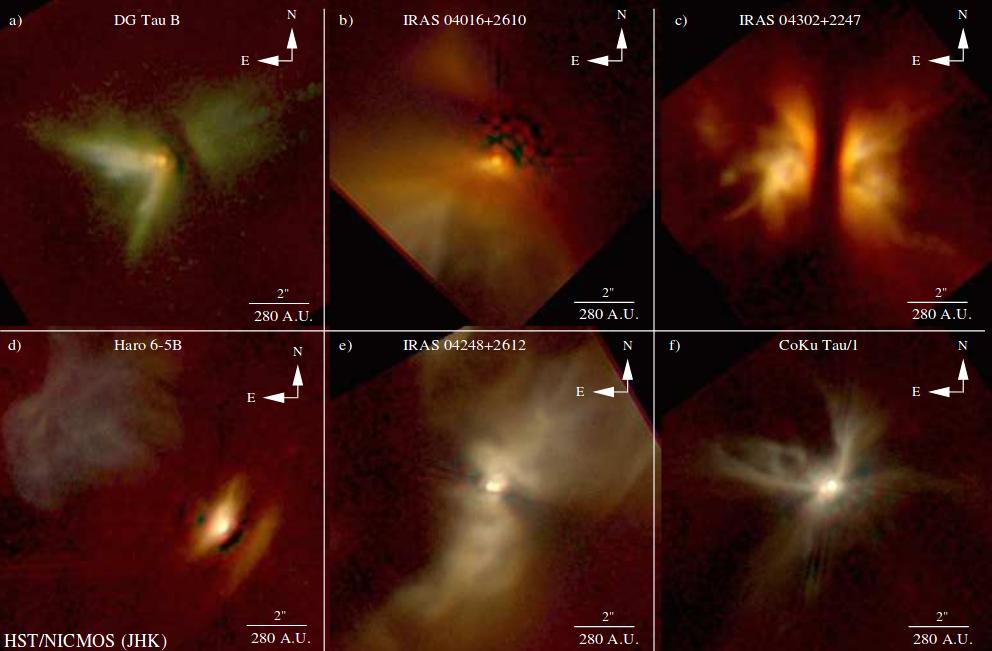
Figure 1 taken from
Padgett et al., AJ 117, 1490 (1999)
But -- hey, those clouds seem a little ... squished; or squashed; or flattened ... or something. They certainly don't look spherical. Hmmmm...
As a cloud of gas and dust collapses due to its own self-gravity, it also changes its shape. Initially a roughly spherical cloud -- like the little protuberances sticking out of this closeup view of the Eagle Nebula --

Image courtesy of
NASA, ESA, and the Hubble Heritage Team (STScI/AURA)
it turns into a flattened disk.
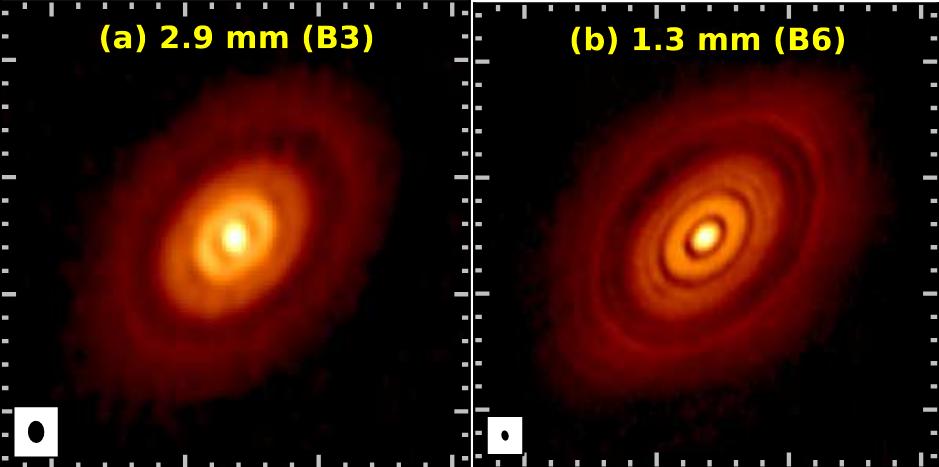
ALMA image of HL Tau,
roughly 2 arcsec = 280 AU on a side, taken from
ALMA Partnership et al., ApJ, 808, 3 (2015)
Why? What causes the cloud to become flat? The (simplified) answer is --- collisions.
Consider the original cloud in its spherical state. The cloud is made up of billions and quadrillions of particles, all flying this way and that at random.

When two particles collide, the result depends on their relative directions.
Now, if the cloud were initially populated with particles moving in truly random directions, with no coherent motion, then the collisions would repeatedly slow down all the particles. After many, many, many collisions, the average speed of the particles would decrease to a crawl. Due to the self-gravity of the entire cloud, the particles would pull each other inward, and the entire cloud would shrink into a tiny little sphere.
But in the real world, the particles inside clouds do not have completely random motions. Instead, due to the many gravitational influences from other objects on the cloud during its long lifetime, its particles will have a slightly un-balanced collection of velocities: overall, the cloud will have some net spin.

Q: In the picture above, in which direction is the
cloud spinning?
When a cloud has some net spin, the collisions between its particles do the following:
After a time long enough for each particle to encounter hundreds or thousands of collisions, the particles will settle down into a disk, spinning in the same direction as the original cloud.
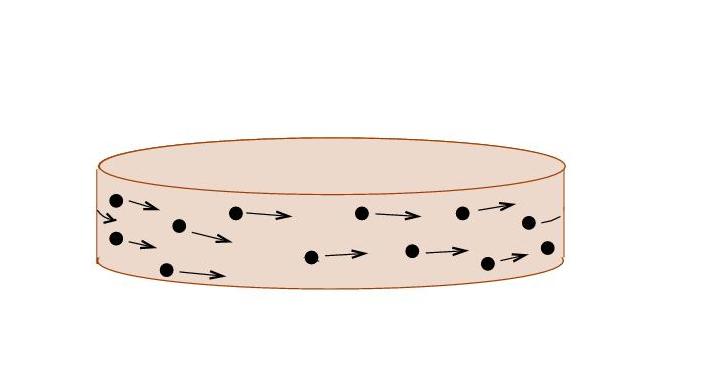
Without collisions, this flattening cannot take place. But our observations of real collapsed young stellar systems tell us that flattening DOES take place.
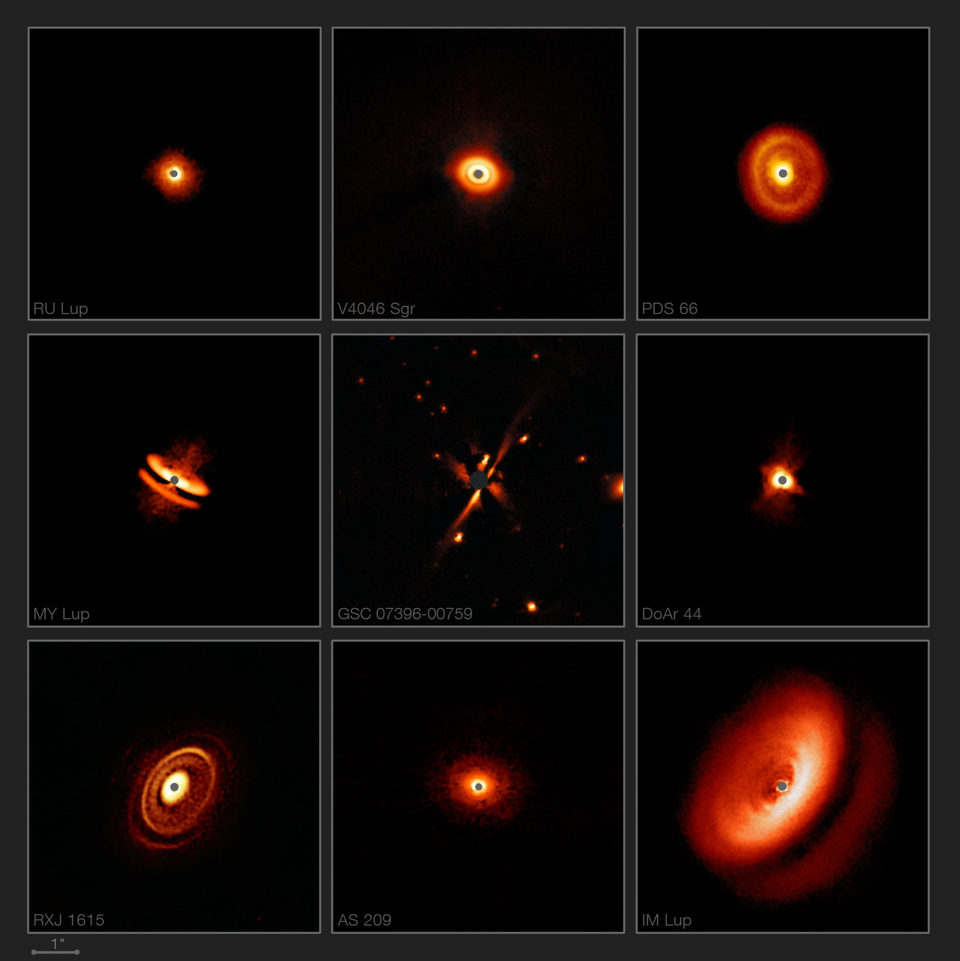
Images courtesy of
ESO/H. Avenhaus et al./E. Sissa et al./DARTT-S and SHINE collaborations
As mentioned earlier, there is good evidence that some initially spherical clouds will flatten as they collapse to form disks. We see disks of several types when we scan the skies: protostellar disks

ALMA image of HL Tau,
roughly 2 arcsec = 280 AU on a side, taken from
ALMA Partnership et al., ApJ, 808, 3 (2015)
and the disks of spiral galaxies:

Image courtesy of
NASA and The Hubble Heritage Team (STScI/AURA)
Yet we also see some systems which appear NOT to have flattened: systems of millions or billions of objects which retain their initial spherical shape. For example, globular cluster of stars
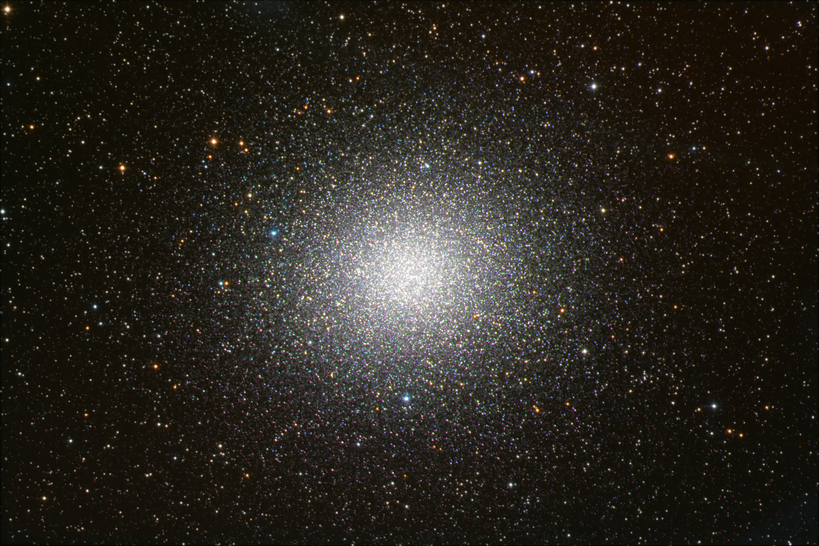
Image of omega Centauri courtesy of
Joaquin Polleri & Ezequiel Etcheverry (Observatorio Panameño en San Pedro de Atacama)
and elliptical galaxies.
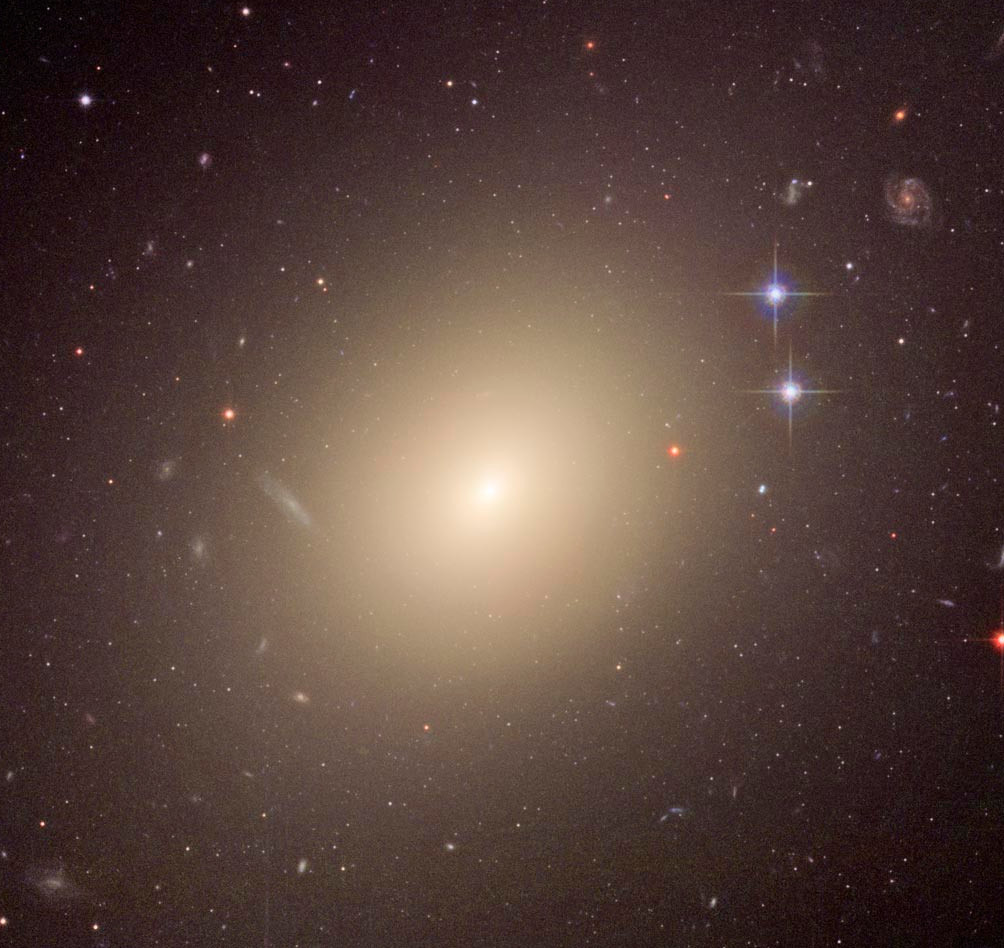
Image of ESO 325-G004 courtesy of
NASA, ESA, and The Hubble Heritage Team (STScI/AURA)
Why do some of these systems remain roughly spherical, while others collapse into flattened disks?
Q: Why do some systems become flat?
(Check your memories and notes from earlier in this lecture)
Right. Collisions. The key here is -- how long does it take the particles in an initial spherical collection to collide with each other?
And it turns out that the answer to that question depends on three factors:
Let's take each of these in turn.
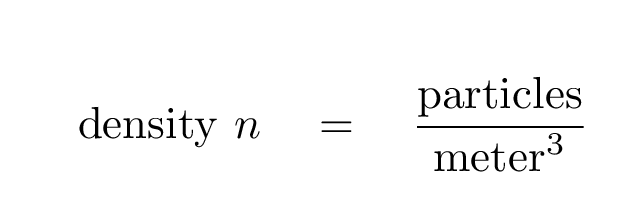
The higher the density of objects, the more likely it is for a particle moving in some random direction to collide with one. That seems pretty obvious.

A small particle trying to zoom through a cloud of other small particles has a good chance to avoid its neighbors, at least for a while. But a large particle, trying to fly through a collection of other large particles, is more likely to bang into one.

And, finally, the faster a particle moves, the quicker it will run into one of its neighbors.
We can put these factors together mathematically. For example, the distance a particle will typically move before it bumps into one of its neighbors is sometimes called the mean free path, and can be calculated like so:

And, finally, the time it takes a particle to move this distance -- and thus the typical time between collisions -- is simply this distance divided by its speed.

Okay! Let's use these formulae to compute the time between collisions of particles in two different, initially spherical systems. The first is made up of gas, the second of stars.
You can watch a video explaining these calculations
![]()
gas cloud globular cluster
------------------------------------------------------------------------------------
density n 1010 atoms/m^3 3 x 10-47 stars/m^3
radius of particle 10-10 m 7 x 108 m
cross section A
velocity v 300 m/s 7000 m/s
mean free path L
collision time t
------------------------------------------------------------------------------------
There -- see the difference? The atoms in a collapsing cloud of gas will collide with each other frequently: in just a few thousands or tens of thousands of years, each one will collide so many times that any "tilted" motions will be evened out, and the cloud will become flat.
But the stars in a globular cluster take much, much, MUCH longer to collide with each other; their separations are just so many times greater (in terms of their size) than the distances between atoms of gas in a cloud. Our universe is only about 13.7 billion years old = 4 x 1017 seconds. There just hasn't been enough time for many collisions to occur, and so the stars remain in their "tilted" orbits, blissfully ignorant of the collisions yet to come.
If you look closely at some of these disks surrounding very young stars, you'll see that there are gaps in the material of the disk. They are especially clear in the disk around HL Tau, for example.

ALMA image of HL Tau,
roughly 2 arcsec = 280 AU on a side, taken from
ALMA Partnership et al., ApJ, 808, 3 (2015)
What causes these gaps? We think that the answer is ... very young planets! Although the details are still under discussion, the basic process probably goes something like this:

Image of the
Semarkona meteorite courtesy of
NASA/ESA
This next step isn't quite so simple. Up to this point, grains and pebbles have been meeting due to random collisions as they all orbit the central proto-star. But to grow significantly larger, random collisions are too slow. We need the help of gravitational forces to speed up the increase in size.
If enough rocks stick together, they may create a planetismal large enough that the object's own gravity starts to attract and collect other material nearby. After reaching this critical size, the planetesimal will grow rapidly, as it slurps up gas, dust, and rocks which share its orbit.
Under the right conditions, planetesimals might grow and collide to form a planet-sized object after 5, or 10, or 50 million years. The figure below shows the results of a simulation of material in a proto-planetary disk. Each little colored dot represents a small, rocky planetesimal. As time passes, note that the small little dots turn into a few big dots -- meaning that the many little planetesimals have merged to form a few big planets.
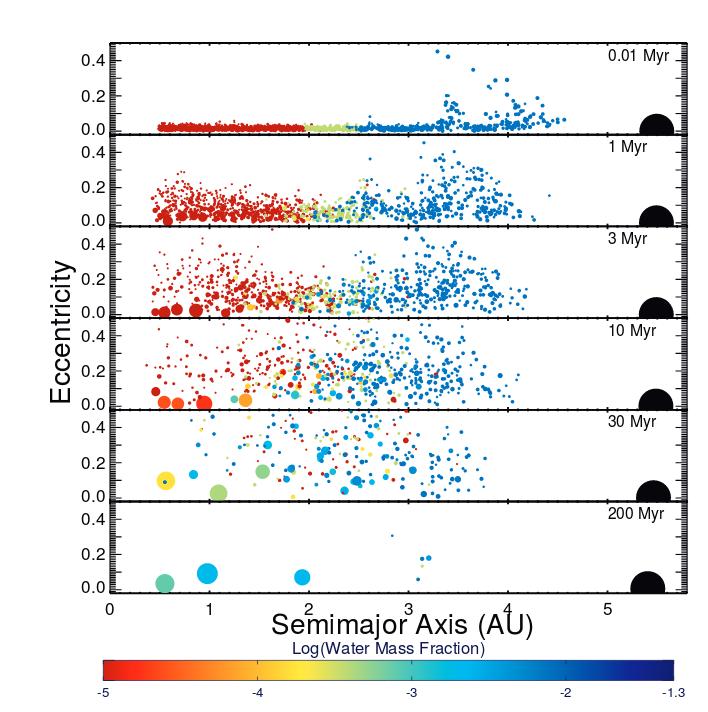
Figure 4 taken from
Raymond et al., in "Protostars and Planets VI",
eds. Beuther et al., University of Arizona Press, Tucson (2014)
Click on the picture below to watch a movie; it shows a bird's-eye view of the disk around a young star as a planet starts to form and create a gap in the disk. Yellow means "high density" and black means "low density."
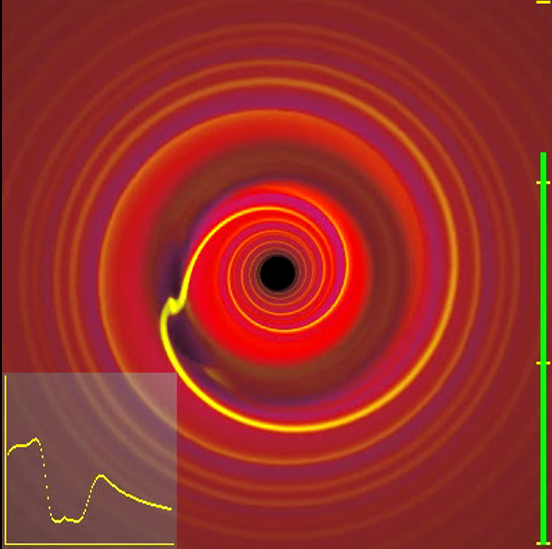
Movie of planet formation courtesy of
Phil Armitage
As clumps of material grow to the size of planets, they clear out the dust and gas in their orbital vicinity -- creating the gaps we see in some observed disks.
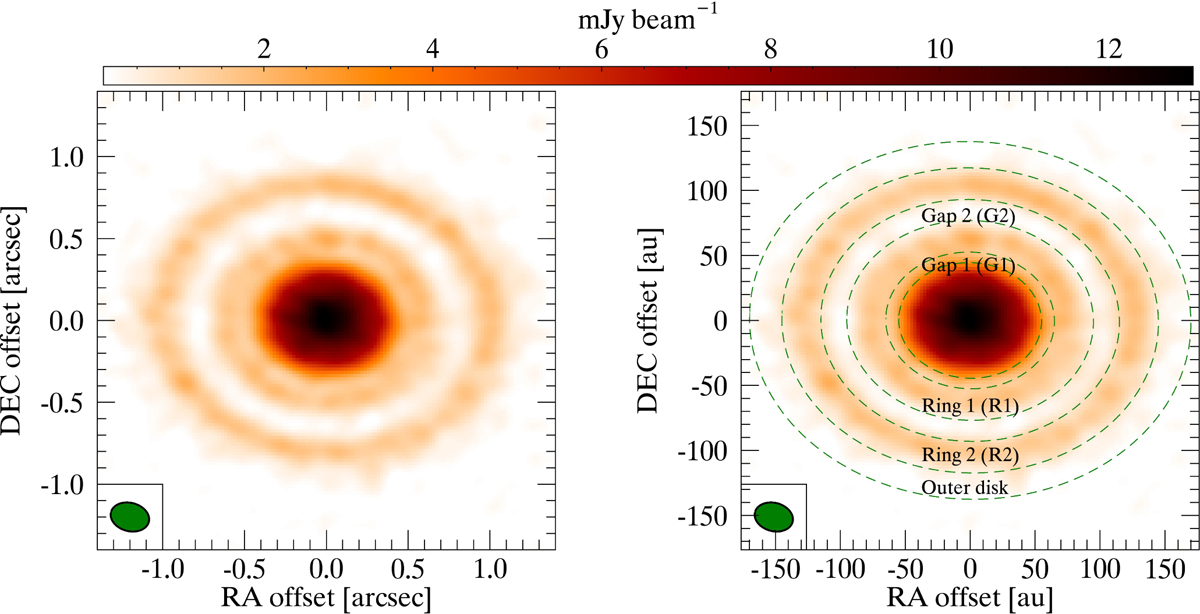
Figure 1 of the disk around AS 209 taken from
Fedele et al., A&A 610, 24 (2018)
In some cases, planetesimals might accumulate to form a planet-sized solid object ... and then stop. That would account for bodies like the terrestrial planets in our own solar system.
But -- clearly -- some of the bodies in our solar system are larger than the Earth-type planets. The gas giants are not only larger, but much more massive, surrounded by titanically thick atmospheres of mostly hydrogen and helium.
How did they form?
We think that those bodies began to form in the same manner:
But at this point, when a sizeable solid core had accumulated, an additional process took over: the accretion of gas from the surrounding disk. If the atoms of gas in the disk close to a new planet-sized core were moving slowly enough, then they might not be able to escape the gravitational pull of the growing planet.
Q: What controls the speed of atoms in a gas?
Right -- the temperature of the gas! In cool gas, the atoms move slowly; in hot gas, the atoms zoom around at high speed.
Q: What controls the temperature of gas in a proto-planetary disk?
The answer is simple: its distance from the young star at the center of the disk.
Let's look again at the planets in our solar system. Where are the gas giants located?
Yes, that's right: the gas giants are all far from the Sun. The innermost one, Jupiter, orbits at a distance of more than 5 times the distance of the Earth from the Sun; in other words, more than 5 Astronomical Units (AU) from the Sun. Saturn and the others are much farther from the Sun. In those distant reaches of the Solar System, the Sun's light grows weak, the temperatures of any gas clouds drop, and the motions of molecules in those clouds are slow.
Current models suggest that the planets formed out of an initial disk of gas and dust over the course of 1 to 10 million years or so. During that period, the central proto-Sun was growing hotter and hotter due to accretion of more and more gas from the initial cloud.
Eventually, the core of the proto-Sun reached a temperature of around 10 million degrees, allow fusion reactions to take hold. At that moment, when hydrogen started to fuse into helium, the proto-Sun turned into the Sun.
The combination of
relatively quickly drives away any remaining gas in the disk.
However, solid material -- large grains, pebbles, rocks, big rocks, planetesimals, and planets -- is too large and massive to be affected strongly by the solar radiation. After a few tens of millions of years, these solid objects (and the Sun, of course) are all that remains of the original cloud.
The graph below shows a quantity related to the amount of dust in a stellar system on the y-axis, and time on the x-axis. Note that after just a few million years, the amount of dust decreases drastically.
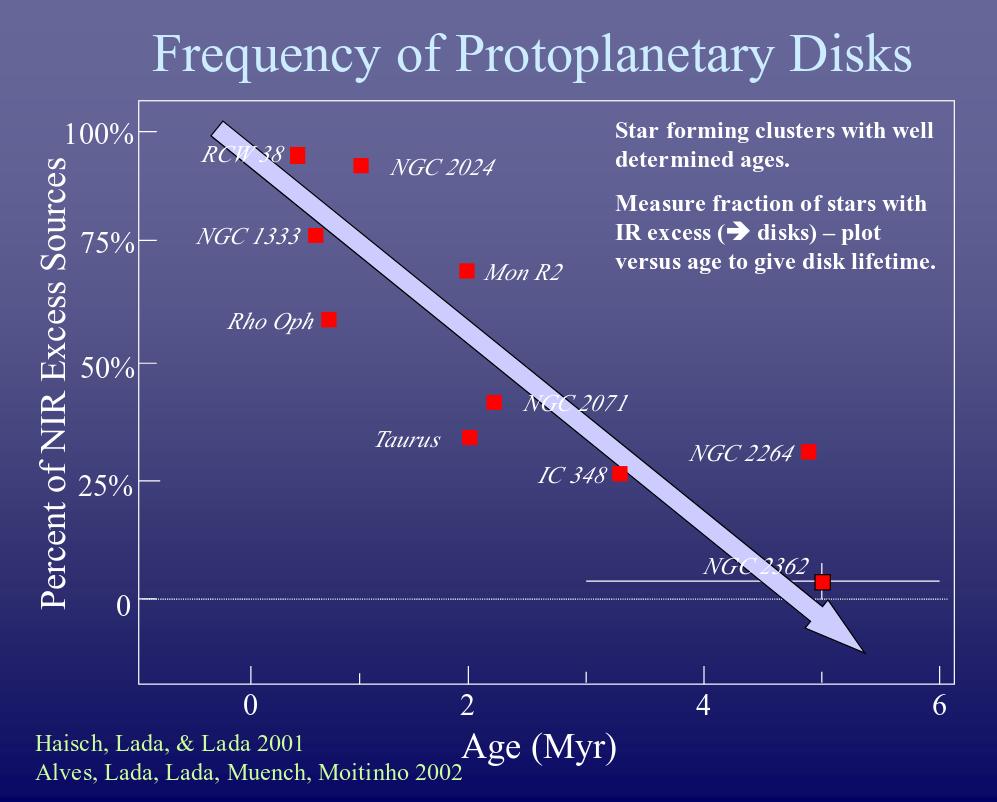
Slide taken from a presentation
on "Molecular Clouds, Bipolar Outflows, & Disks:
I. Introduction Molecular clouds – the birth place of stars" by
Debra Shepherd, National Radio Astronomy Observatory
 Copyright © Michael Richmond.
This work is licensed under a Creative Commons License.
Copyright © Michael Richmond.
This work is licensed under a Creative Commons License.